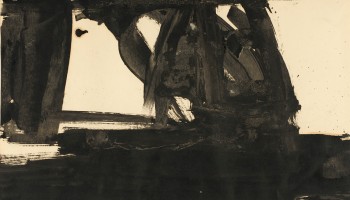Abstract Expressionism and Its Discontents

At Pennsylvania Academy of the Fine Arts
PHILADELPHIA –Abstract Expressionism and its Discontents, a new installation at the Pennsylvania Academy of the Fine Arts (PAFA) on view through August 28, 2011, revisits the post-World War II art movement to include artists historically not associated with Abstract Expressionism.
When in 1946 New Yorker critic Robert Coates identified an expressive, gestural and subjective approach towards abstract painting in American art, he inadvertently gave the name to a style popularly known as “Abstract Expressionism.” Although it has come to describe spontaneously-composed abstract painting, the label encompassed an extraordinarily diverse array of approaches, ranging from Jackson Pollock’s dizzying high-energy poured paintings to Mark Rothko’s hovering rectangles of meditative color.
While critics celebrated Abstract Expressionism’s stylistic diversity, its written history remained that of a “boys’ club” in which the parallel contributions of women, African-Americans, and homosexual artists were downplayed or ignored. Only in the past two decades have the crucial roles of artists such as Norman Lewis, Joan Mitchell, and others been returned to their rightful place at the heart of the story.
Abstract Expressionism and its Discontents places artists who have been considered central to the development of Abstract Expressionism in direct confrontation with artists who have often been relegated to its periphery. These juxtapositions offer a fresh look at how a wider group of artists around 1950 integrated personal and collective symbols with the expressive capacity of abstraction. Works by mid-century figure painters appear in the installation to reveal that some artists who publicly rejected the underlying premises of Abstract Expressionism managed to adopt techniques learned from its core practitioners. They also often worked out of the unconscious (later ordering that initial inspiration) and arranged space to emphasize psychological states.
“Abstract Expressionism was an extraordinarily influential episode in American art — affecting artists of a wide range of political viewpoints and even affecting realists who we would not immediately associate with the style,” says Robert Cozzolino, Curator of Modern Art. “Philip Evergood and Dorothea Tanning, for instance shifted their approaches to accommodate lessons learned from artists such as Pollock and De Kooning; it’s there, though not in obvious ways at first glance. I am interested in putting these artists together to try and revisit the excitement and possibilities of the time and remind viewers that it wasn’t as polarized an artworld as history books like to portray; the realists and the abstract artists showed together in the 1950s and often exchanged ideas.”
Selected largely from the Academy’s permanent collection with several generous loans from private collections, artists featured in this installation include: Walter Anderson, Byron Browne, Kenneth Callahan, Willem De Kooning, Phillip Evergood, Adolph Gottlieb, Philip Guston, Grace Hartigan, Robert Keyser, Franz Kline, Lee Krasner, Norman Lewis, Loren MacIver, Conrad Marca-Relli, Joan Mitchell, Robert Motherwell, Jackson Pollock, Mark Rothko, Sonia Sekula, David Smith, Nancy Spero, Hedda Sterne, Theodoros Stamos, Dorothea Tanning, and Robert Vickrey.
The exhibition features recent acquisitions to PAFA’s collection including major works by Norman Lewis and Theodoros Stamos.
